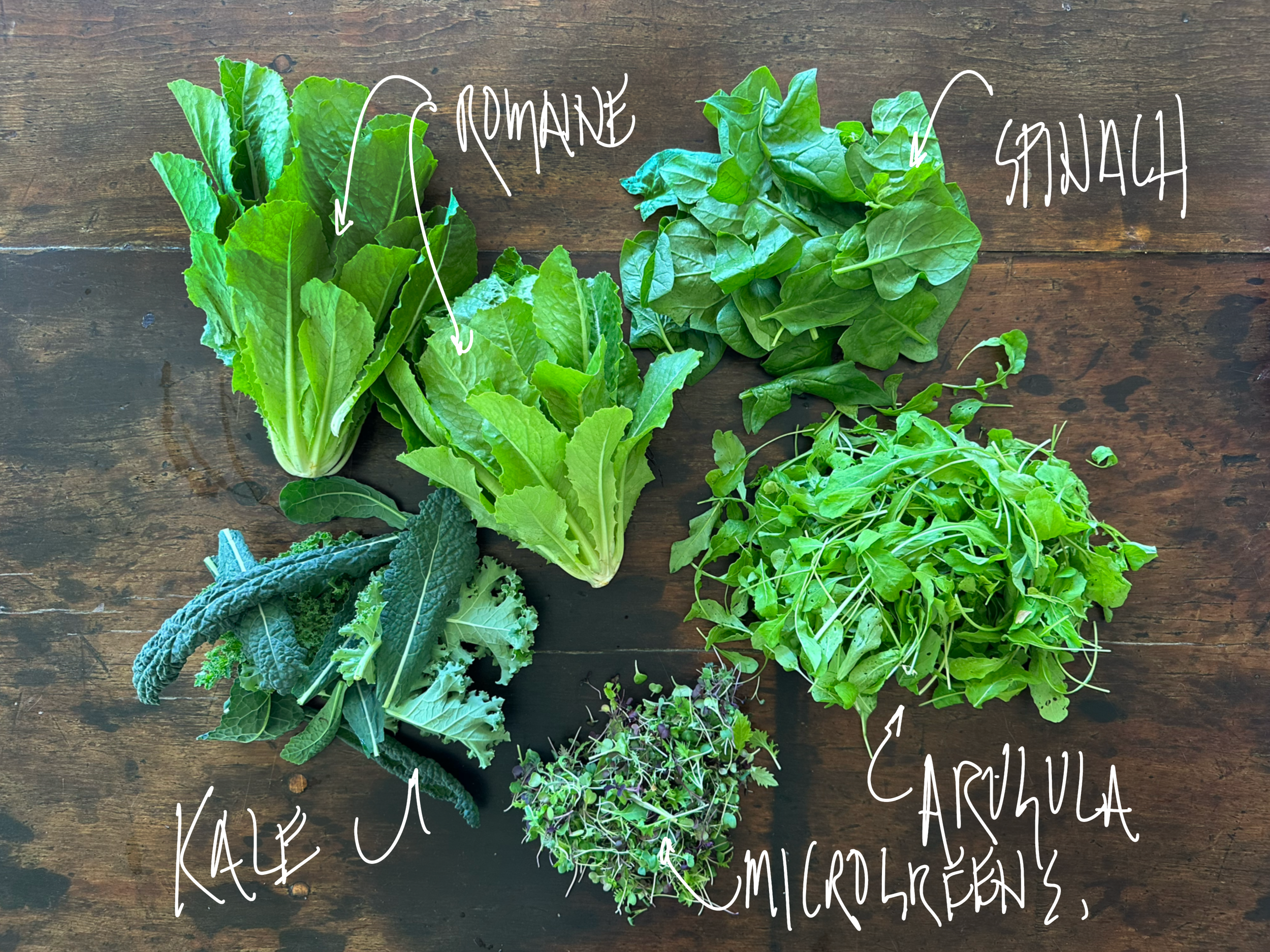2025 Season | Week 5
Arugula Fun Facts
Her’s the first arugula of the swason and it’s SPICY. Here’s the top ten interesting facts about one of our favorite crops:
Ancient Green: Arugula has been eaten since Roman times and was even mentioned in the Old Testament. Ancient Romans believed it was an aphrodisiac!
Spicy & Peppery: Its distinct peppery, mustard-like flavor comes from compounds called glucosinolates, which are also found in broccoli and mustard greens.
Not Just a Leaf: Every part of the arugula plant is edible—including the flowers, seeds, and stems, not just the leaves.
Quick Grower: Arugula is a fast-growing plant, often ready to harvest in just 3–4 weeks after planting.
Cool-Season Crop: Arugula thrives in cooler weather. If grown in hot climates, it tends to bolt (go to seed) quickly and become more bitter.
Hydration Helper: Arugula is about 90% water, making it a hydrating addition to salads and smoothies.
Nutrient-Dense: It’s rich in vitamins A, C, and K, as well as calcium, potassium, and folate, all while being very low in calories.
Pollinator Friendly: Arugula flowers are great for attracting pollinators like bees to your garden.
Pungent Preservation: Arugula was once used to preserve food—its natural antimicrobial properties made it a handy ingredient in ancient times.
Global Identity: It’s known by many names around the world—"rocket" in the UK and Australia, "rucola" in Italy, and "roquette" in France. Enjoy the week.
Here’s what’s in your crate this week.
-
KALE 101 - Wash leaves in lukewarm water. If your greens have thick stems, remove them by folding each leaf in half and slicing out the stem. Then, stack the leaves up and slice diagonally into 1” wide strips.
EAT NOW - Wrap unwashed chard or kale in a sealed plastic bag in the crisper drawer of the fridge. Best used very fresh, but may last for a week. To freeze, blanch washed greens, rinse in cold ice water, drain, and pack into airtight containers.
OR LATER - Swiss chard or kale can both be eaten raw or cooked. A longer cooking time is best as it brings out the sweetness in the greens. Extremely high in vitamin K and vitamin A, these nutrient-dense greens can help combat cancer and reduce blood pressure! Chard and kale can be used interchangeably with: collards, turnip greens, beet greens, broccoli raab, mustard greens, dandelion, and spinach.
-
Microgreens 101—Before use, rinse gently in cool (not hot or cold) water to remove excess dirt. Pat or spin dry, and you’re good to go! Pat or spin dry your greens to remove excess moisture (moisture = mush!). Place loosely in a plastic bag or container and put in the fridge. They will keep for up to one week.
Eat These Immediately!
-
ROMAINE 101 - Romaine lettuce belongs to the lettuce family, Asteraceae, and it is characterized by its elongated, sturdy leaves and crisp texture. It is a nutritious vegetable, rich in vitamins and minerals. Romaine lettuce is an excellent source of Vitamin A, Vitamin K, folate, and fiber.. If you’re looking for low carb options, try using the large leaves as a wrap with your favorite fillings. Or, whip together a crisp and delicious salad by mixing with other greens and your favorite fruits, nuts, or cheeses!
EAT NOW - Slice the head of your lettuce at the base with a knife and let the leaves fall open. Remove any damaged or leathery leaves, then tear remaining into bitesize pieces. Wash in a basin of cold water and spin dry.
OR LATER - Store unwashed lettuce in a plastic bag in the refrigerator. If you’ve already washed and dried it, place in a plastic bag with a dry paper towel in the bag as well and place in the vegetable crisper of your refrigerator.
RECIPES
-
SPINACH 101 - This versatile, leafy green is packed with nutrients and antioxidants. Plus, it’s a great source of plant-based iron! It can be eaten raw or lightly cooked. To get the most out of your cooked spinach, briefly blanch, steam, or sauté until it turns bright green.
EAT NOW - Swish leaves in basin of cool water and let sit for a minute to remove grit. Then, spin or pat dry. Ready to eat raw! If you want to cook your spinach, blanch, steam, or sauté til just wilted. Color will brighten beautifully to signal it is done. Serve immediately.
OR LATER - Keep dry, unwashed greens in a sealed plastic bag in the refrigerator up to 1 week. To freeze, blanch washed greens for 1 minute, drain, and pack into airtight containers and place in freezer - will keep for up to a year. Frozen spinach is a great addition to smoothies!
To blanch, bring a pot of lightly salted water to a rolling boil. While you wait for boil, prepare an ice bath. Once boiling, drop veggies into water - water should return to boil within a minute otherwise you have too much veg for the water. Once boil has returned, cook for 1-5 min until veg has a vibrant color. Immediately put into ice bath to stop cooking.
RECIPES
-
ENJOY NOW
Arugula is highly perishable and will only last about 2 days. Store in the fridge inside a perforated plastic bag. If you decide to wash it first, be sure to spin the leaves dry before placing them loosely into a Green Bag with a dry paper towel to absorb the moisture.
ENJOY LATER
Blanch leaves in boiling water or steam for two minutes, followed by soaking in ice water. Remove from ice water, spin it dry in a salad spinner or blot it on a thick towel. Freeze"balls" of arugula on a cookie sheet in individual portions. When frozen, pop them into a Ziploc bag.

